
AI-Powered
Returns Solution for eCommerce
Use the power of AI to reduce, automate, and manage returns seamlessly. Designed for Shopify, Magento, and WooCommerce stores, EcoReturns transforms returns into a strategic advantage for your brand.
*No credit card required
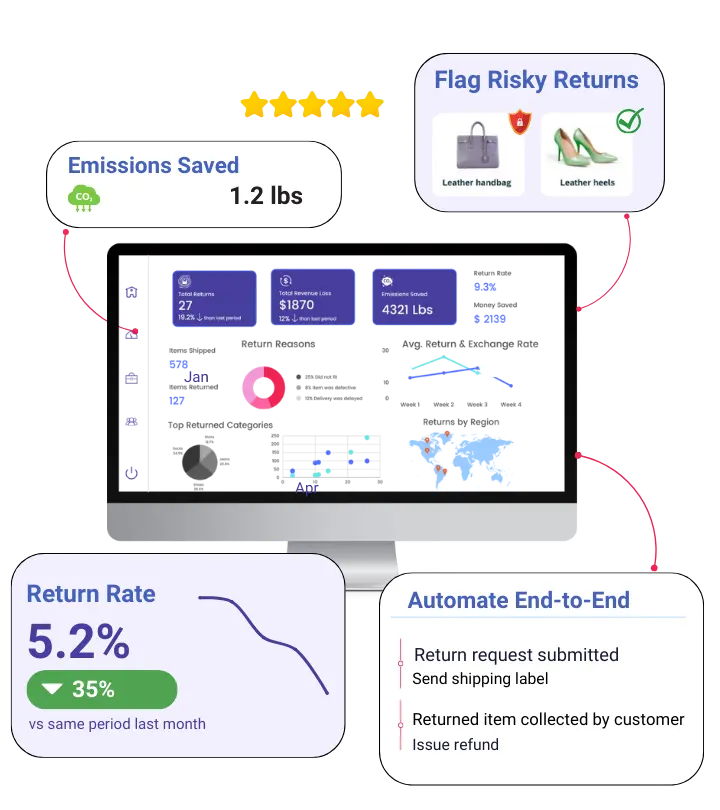

Why EcoReturns


World's first
ChatGPT-Powered Returns Solution
Most customers feel unhappy when requesting a return. Understand their needs and offer an A-class customer experience with the world’s first ChatGPT-powered returns solution.
- Personalized support
- Never-known-before insights on returned products
- 30% reduction in returns
prevent fraud
AI-Powered Returns Fraud Prevention
Prevent returns fraud by flagging risky customers with the powerful AI engine of EcoReturns.
- Flag suspicious return/exchange requests
- Get reasons of the fraudulent returns
- Get suggestions on ways to prevent returns fraud
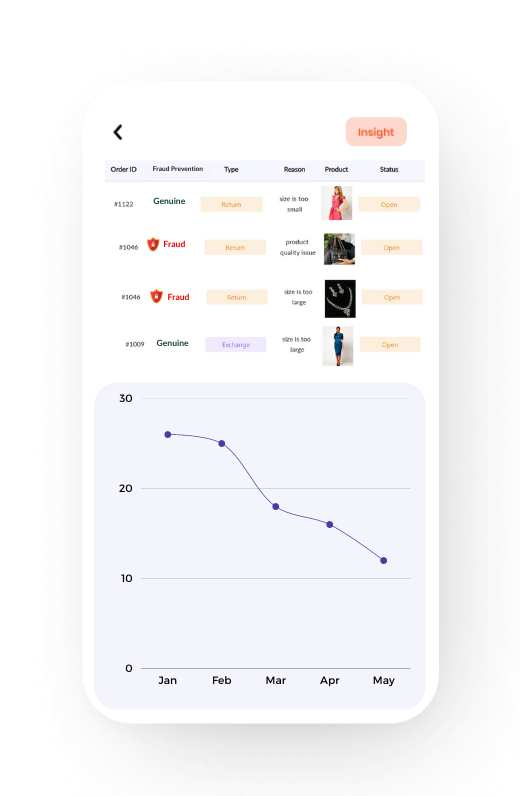

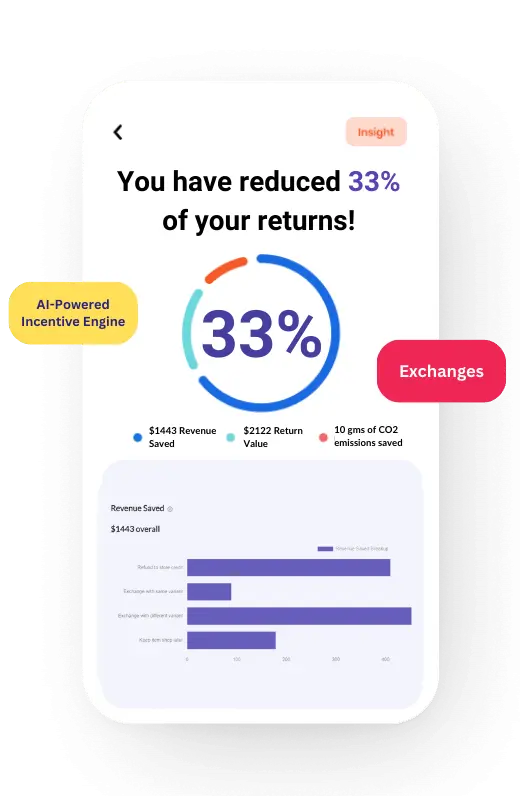

REDUCE RETURNS
AI-Driven Returns Reduction
A 3-layered returns reduction technology including returns fraud prevention, AI-powered incentivization and ChatGPT returns, ensures you scale your brand by cutting down returns and costs associated with returns.
RETURNS AUTOMATION
Automate returns, exchanges and refunds
No more manually processing returns. Save time and money with easy-to-configure automation rules. Automate reverse shipments, label generation, pick-ups, exchanges, and refunds to reduce TAT and increase efficiency.
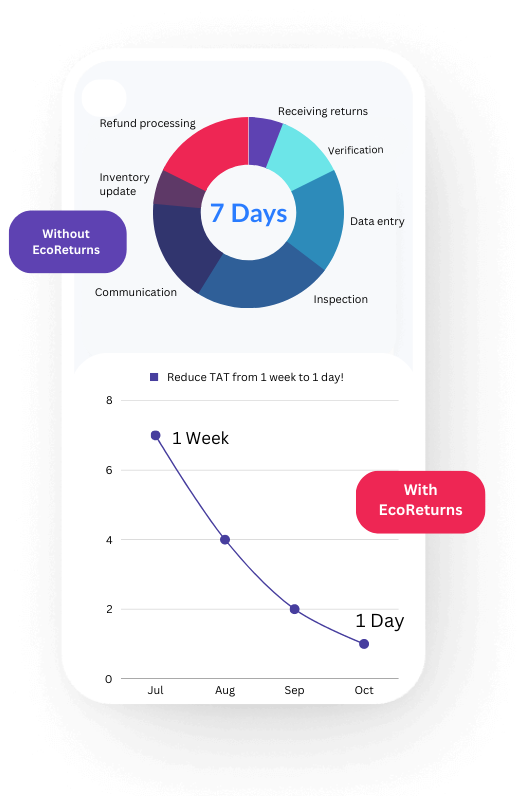

Other Features
Scale your online store from 0-1 or 1-100 with the diverse range of features EcoReturns offers.
Site-wide Exchanges
Encourage shoppers to exchange either with product variants, all products from your catalog or selected products of your choice – without having to move outside of your website flow!
Deep Analytics
Prevent returns with access to highly useful data such as top return reasons, customers who return the most, top returned categories and many more.
Store Credits & Wallet
Offer store credits in the form of incentives or refunds so that your shoppers keep coming back to your store.
Branded Returns Portal
A highly configurable returns portal that allows you to offer self-service returns/exchanges to shoppers. Let them return a product as easily as they purchased it from your store!
Real-time Notifications
Notify your customers via text email & Whatsapp about their return/exchange status at every stage of the process.
Unlimited Return Policies
Create unlimited return policies for your store and restrict return/exchanges based on your policies.
Discounted Labels
Generate discounted return labels using our inbuilt label generation system or connect your own shipping provider.
Flexible refund options
Offer refunds to originial payment mode, in the form of store credit or gift card wallet.
Packages
Use package templates for easier input of package weight and dimensions
Our Integration Partners
with API support…
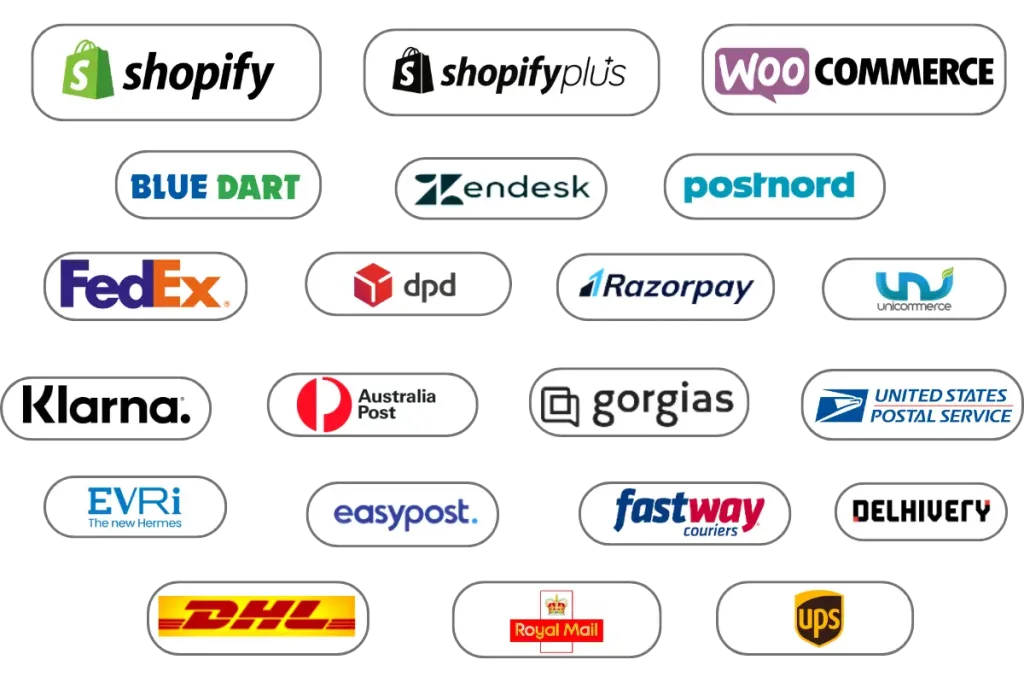

Simple, affordable plans for brands of all sizes
Free to install
$0
Shipping label charges may apply
- Branded returns portal
- Inbuilt discounted shipping labels
- Unlimited return reasons
- Unlimited return policies
- Exchange with same product variant
- Single Warehouse
advanced
$19
60 Returns/Exchanges, 3 users, $0.40 per extra return
- Label, exchanges, refund automation
- Branded email notifications
- Deep analytics
- Connect with multiple providers
- Exchange with all products
- Multiple warehouses
ultimate / enterprise
$89
Includes 100 Returns/Exchanges, $1 per extra return
- All advanced features
- Unlimited advanced automation rules
- ChatGPT-Powered returns
- Text/Email/WhatsApp notifications
- Unlimited AI tools to reduce returns
- APIs and Webhook support
Go Live in Just 5 Minutes!
Say goodbye to lengthy onboarding! Our returns app lets you go live in just a few minutes with a dedicated product expert guiding you through the process.
Frequently Asked Questions
EcoReturns mission is not just to help you manage and automate your returns but also to reduce your returns so that you can become more profitable. EcoReturns has very high level of automation and it uses AI to cut down returns so that you can be more profitable. EcoReturns is the only returns solution in the world that uses ChatGPT/Generative AI to help you improve customer experience while reducing your cost.
Ecoreturns offers comprehensive returns analytics. EcoReturns dashboard including return rate, revenue saved, return/exchange Turn Around Time, most returned products, and much more.
You can automate almost everything in your returns management. Some of those are Self service request submission, Automatic acceptance or rejection based on reasons, collecting reverse shipment fee , generating labels or creating a reverse pickup, automatic exchange creation and shipment, automatic refunds including COD and more.
Your shoppers can request an exchange in your own website without being taken to any external site.
Yes, EcoReturns supports dropshippers too. To know more about returns for dropshippers, click here.
EcoReturns allows you to create unlimited return and exchange policies. You can configure policies based on return window, orders types, sale running, location based, return reason and many more. Our experts can help you setup any kind of policies you may have in mind.
Managing returns can get cumbersome if not handled properly. You can automate your returns end-to-end with EcoReturns including automation of shipping label, pickups, refunds, creating exchange orders and more. You can manage all your return orders in a single dashboard.
The basic ecommerce return policy outlines the rules and procedures that customers must follow when returning purchased products to an online store. While return policies can vary between different ecommerce businesses, a typical basic return policy may include the following elements:
Timeframe for Returns: Specify the time limit within which customers can initiate a return. It’s common to offer a 14 to 30-day window from the date of delivery.
Condition of the Item: State that the product must be returned in its original condition, unused, and with all original tags and packaging intact.
Reason for Return: Ask customers to provide a reason for the return, which can be helpful for understanding customer feedback and improving products or services.
Return Shipping Responsibility: Clarify whether the customer or the store will be responsible for covering the return shipping costs. Some stores offer free returns, while others may require customers to pay for return shipping.
Refund or Exchange Options: Clearly state whether customers can get a refund to their original payment method or opt for an exchange for a different item.
Exceptions or Non-Returnable Items: If there are certain products that cannot be returned (e.g., perishable items, personalized products), mention them in the policy.
Instructions for the Return Process: Provide step-by-step instructions for initiating the return, including contact details or a link to the return request form.
Timely Refunds: Assure customers that refunds will be processed promptly after the return is received and inspected.
Customer Support: Include contact information or a link to customer support for any return-related queries or concerns.
International Returns (if applicable): If your store ships internationally, address how returns from different countries will be handled.
Remember that the return policy should be easy to understand and written in clear and concise language. Display the policy prominently on your website, preferably on the checkout page, product pages, and a dedicated “Returns and Refunds” page. A transparent and customer-friendly return policy can build trust with your shoppers and improve their overall shopping experience.
Ofcourse sellers can refuse returns based on certain criteria. If the photo of the product during return shows certain discrepancies, merchants can easily restrict a return from the EcoReturns dashboard.
Yes, EcoReturns supports inbuilt label generation system.
You can expect your TAT to reduce from several days or weeks to less than 1 day with EcoReturns automation rules.
The average return rate for ecommerce is between 15-20% as compared to 8% in brick and mortar stores.
Returns can be resold, but there are some important considerations and factors that ecommerce businesses need to take into account. The decision to resell returned items depends on the condition of the product, the type of product, and the company’s return policy.
Here are some key points to consider regarding reselling returned items:
Product Condition: If the returned item is in new or like-new condition, it can usually be resold without any issues. However, if the product is damaged, used, or missing parts, it may not be suitable for resale and might need to be categorized as defective or unsellable.
Return Policy: The ecommerce store’s return policy should clearly outline the conditions under which returned items can be resold. If the policy allows for reselling items that are in good condition, the store can proceed with the resale process.
Inspection and Quality Control: Before reselling any returned item, it is crucial to inspect the product thoroughly to ensure it meets the store’s standards for resale. Quality control measures should be in place to avoid sending out faulty or damaged products to customers.
Product Type: Some products, especially items that are perishable, personal care products, or items with hygiene concerns, may not be suitable for resale due to health and safety regulations.
Shopify does not charge any additional fees specifically for processing returns. However, it’s important to note that the cost of return shipping and any associated expenses may still be incurred by the store owner, depending on the store’s individual return policy.
Shopify does not charge any additional fees specifically for processing returns. However, it’s important to note that the cost of return shipping and any associated expenses may still be incurred by the store owner, depending on the store’s individual return policy.




